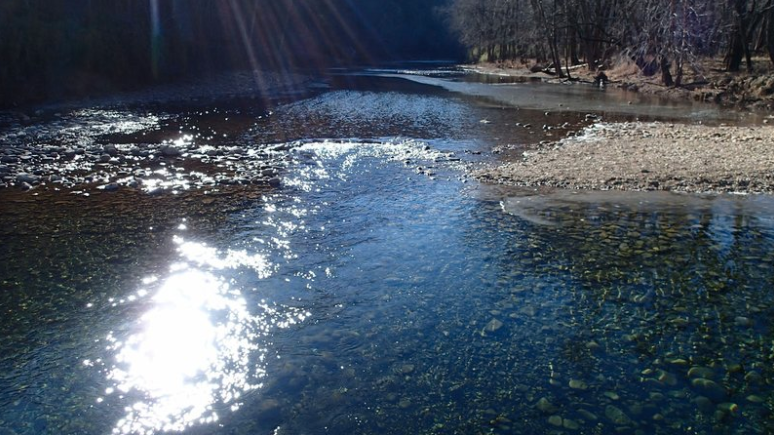Visitors to the Buffalo National River should watch out for algae on the river that has the potential to produce cyanotoxins, the National Park Service said in a news release Friday.
Cyanotoxins are naturally occurring toxins produced by bacteria known as cyanobacteria, which is also known as blue-green algae. Cyanotoxins can be harmful to humans and pets, but so far none have been detected during testing on the river, according to the National Park Service.
"The river's still safe," said Shawn Hodges, the ecologist for the Buffalo National River. "We haven't found anything that would link any illnesses with contact with the water."
Eight people have reported illnesses to the Park Service after visiting the river this summer, the Park Service said Friday.
The toxins can cause rashes, coughing, watery eyes and sneezing or, if ingested, nausea and diarrhea, said Hodges and Dr. Dirk Haselow, the state epidemiologist. Hodges said symptoms may take a week or two to show up.
Tests on "less than a handful" of those who have reported illnesses have not indicated toxins so far, Haselow said. Not all of the eight people have returned messages from the Arkansas Department of Health or conducted interviews with the department about their symptoms, he said.
Haselow said that because of the small number of people who have reported illness and the lack of a connection between the illnesses and the river, he could not say in what portion of the Buffalo those people had floated or swum. But they were not on the portion of the river the Arkansas Department of Environmental Quality recommended for impairment declaration, he said.
On Thursday, the Department of Environmental Quality recommended 14 miles of the river be declared impaired because of excessive pathogens, which can cause disease.
"Thousands of people use the Buffalo every day, and what we're hearing about is less than [a] handful of potential illness that at this point we have not linked to the Buffalo," Haselow said.
The Park Service is discouraging people from swimming near the algae, which has been found in the middle and lower portion of the river.
Tests run on four samples of the water taken July 17 haven't shown toxins at levels that are detectable or exceeding U.S. Environmental Protection Agency thresholds, according to the Park Service release.
Water tests done by the Health Department also did not show excessive E. coli, fecal coliform, turbidity or acidity, Haselow said.
Weeks of mid-90s temperatures and little precipitation have aided algal blooms on the slow-moving river, Haselow said, but no weather conditions or other factors can help predict whether the algae will secrete toxins.
Toxins are "rare, brief and unpredictable," Haselow said. The initial toxin release can be prominent, but toxins break down quickly.
Recent rains may get rid of some of the algae by washing it downstream, Haselow said.
Algae is always present on the river, Hodges said, but it has been worse in the past few years for reasons officials can only speculate about.
Nutrients that cause algae have been increasing in the river for decades, and the past few years could have been a tipping point, Hodges said.
Various agencies -- including the U.S. Geological Survey, the Arkansas Department of Environmental Quality, the Arkansas Game and Fish Commission and the National Park Service -- will begin testing and sampling next week to determine the causes of algae and the sources of nutrients in the water.
The testing will look at species of algae and collect nutrient samples, Hodges said. Researchers will examine the isotopes, which could indicate whether a pollutant came from a ground source, such as nutrients embedded in soil over long periods of time, or a surface source -- a short-term source, such as a spill or a leak of manure or septic systems.
In Mill Creek -- a tributary of the Buffalo River -- the U.S. Geological Survey and the Arkansas Department of Environmental Quality are already researching whether a source is humans, livestock or wild animals.
Visitors to the river have complained in recent years of algae in the middle stretch of the Buffalo, near U.S. 65. On Friday, a Newton County resident presented a slideshow of photos of algae on the river to the Arkansas Pollution Control and Ecology Commission, which is the regulatory and appellate body of the Department of Environmental Quality.
Carol Bitting said dozens of miles of the Buffalo had algae. Bitting said she was concerned the cracks in the area's rough karst terrain meant that pollutants traveled easily throughout the river's watershed.
Haselow said the Health Department has not tested people for illness from algae on the Buffalo since he went to work at the department in 2011, but he's not sure whether this is a first for the department, given that the river has had algae issues previously.
"It's certainly a very rare event," he said.
The news release encouraged people who believe they or their pets have become ill from algae exposure to report it to the Department of Health's communicable disease nurse at (501) 537-8969 during the day or the Emergency Communication Center after hours at 1-800-651-3493. They can also email the National Park Service epidemiology branch chief for the Office of Public Health at [email protected].
Metro on 07/28/2018

